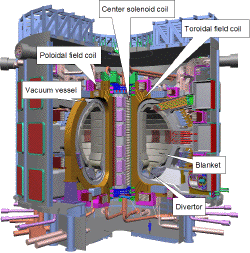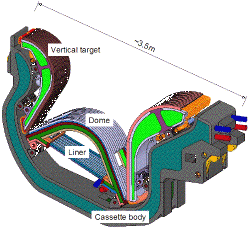In a fusion reactor, burning plasma with high temperature and high density should be sustained for a long period. In-vessel components which is directly facing the plasma are called "Plasma Facing Components (PFCs)". The PFCs mainly consist of "First wall" and "Divertor".In JAEA, the ITER divertor is developed in our group.

The cross section of ITER is shown in the left figure. The divertor (shown in pink in this figure) locates below the plasma. As shown in the right figure, the divertor cassette is installed there. Since the divertor is across the magnetic field line to confine the plasma, it is directly exposed to a heat/particle fluxes from the plasma. The role of the divertor is not only to exhaust impurity particles but also to remove heat load from the plasma.
The heat load to the ITER divertor is estimated as follows;
Heat load to the divertor in normal operation
- in steady state operation 5 MW/m2
- in transient operation max. 20 MW/m2 for 10 seconds
The ITER divertor is subjected not only to the heat loads described above, but also to extremely high heat load in plasma disruption. The plasma disruption is an event that the plasma instantaneously collapses in 0.1 or several milli-seconds. In such case, the energy stored in the plasma falls on the divertor, and the heat load is estimated to be several hundreds or several thousands times more than that in normal operation. There is no durable materials which can endure such high heat load without any damage. Therefore, it is important to develop materials which can minimize the damage as low as possible.

